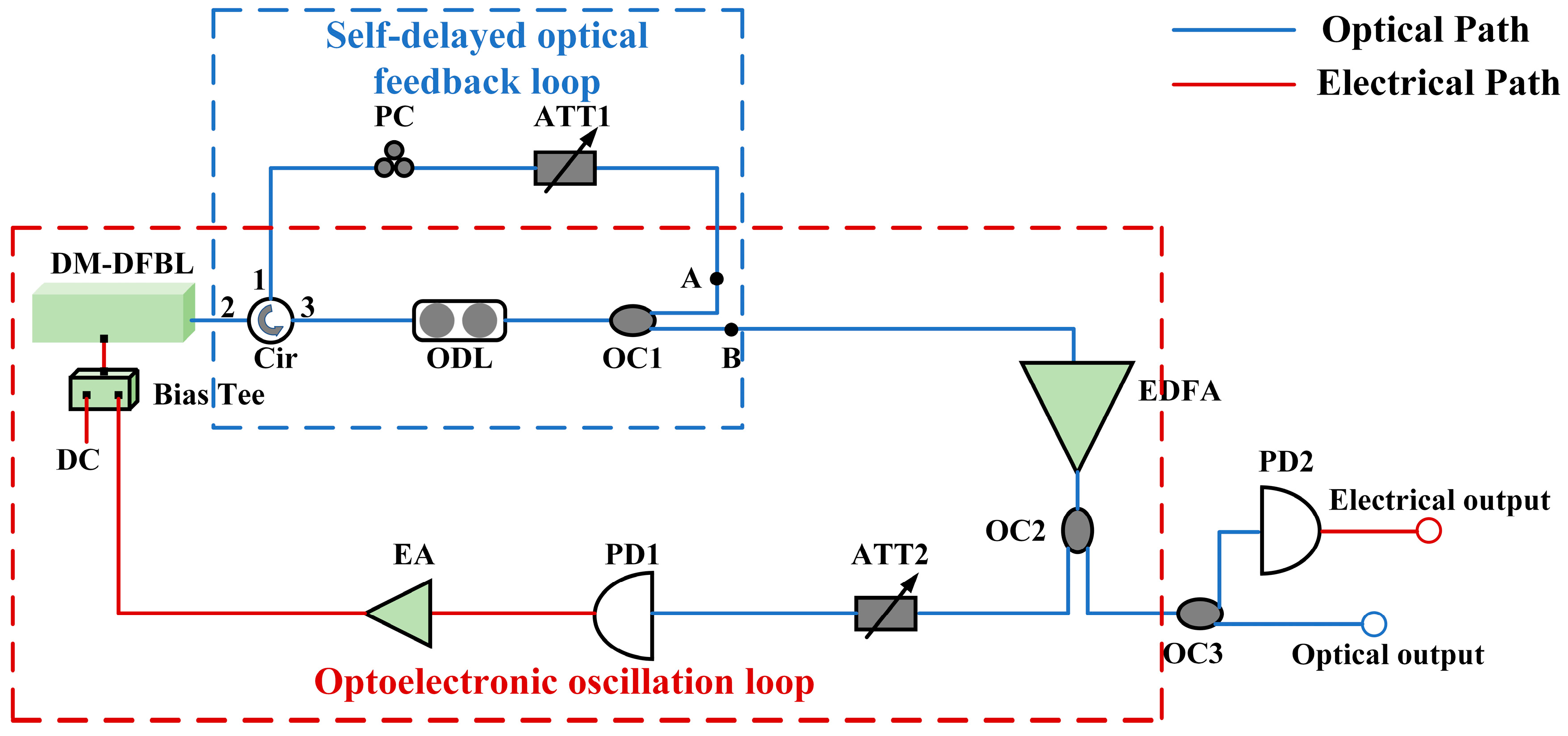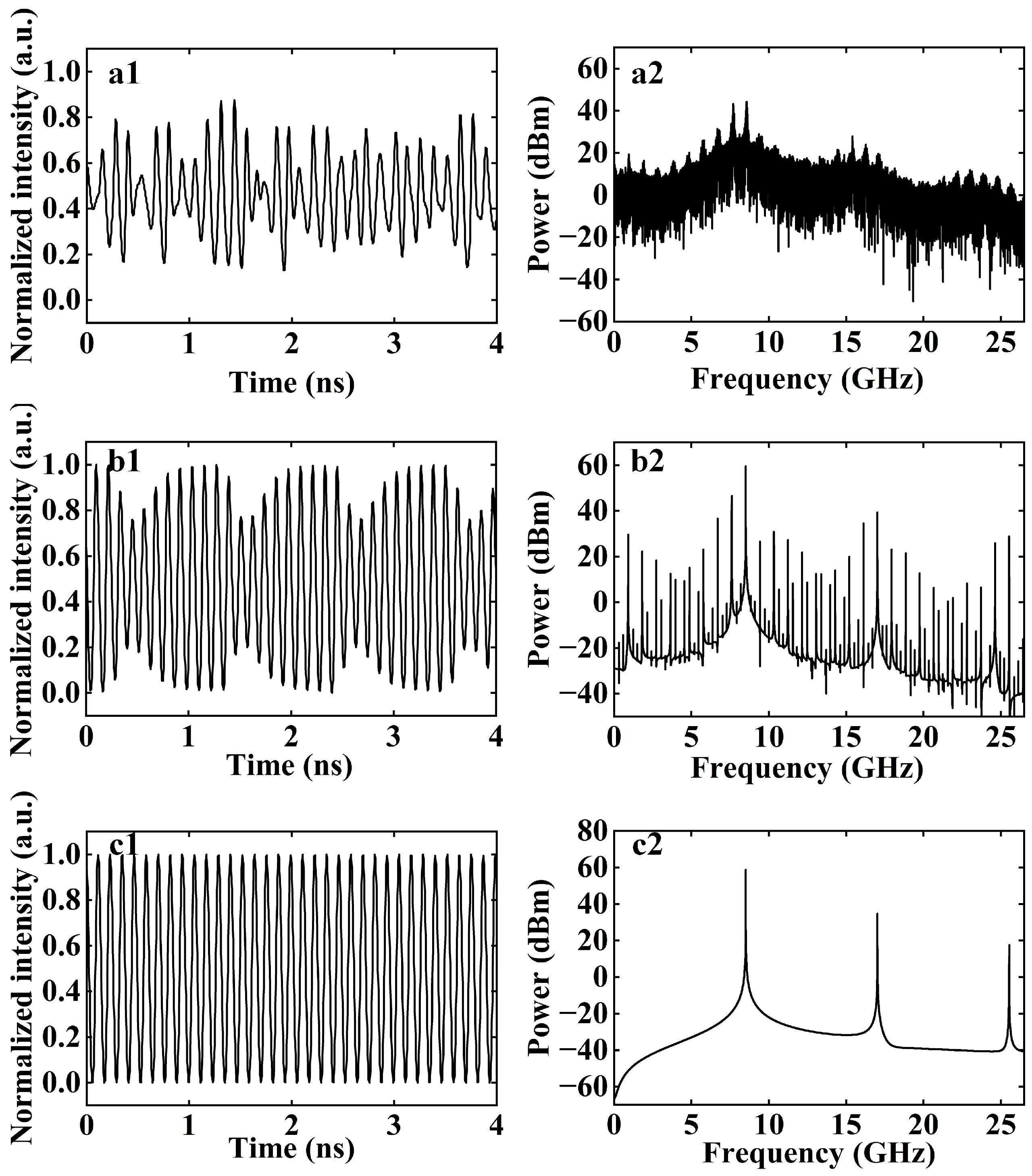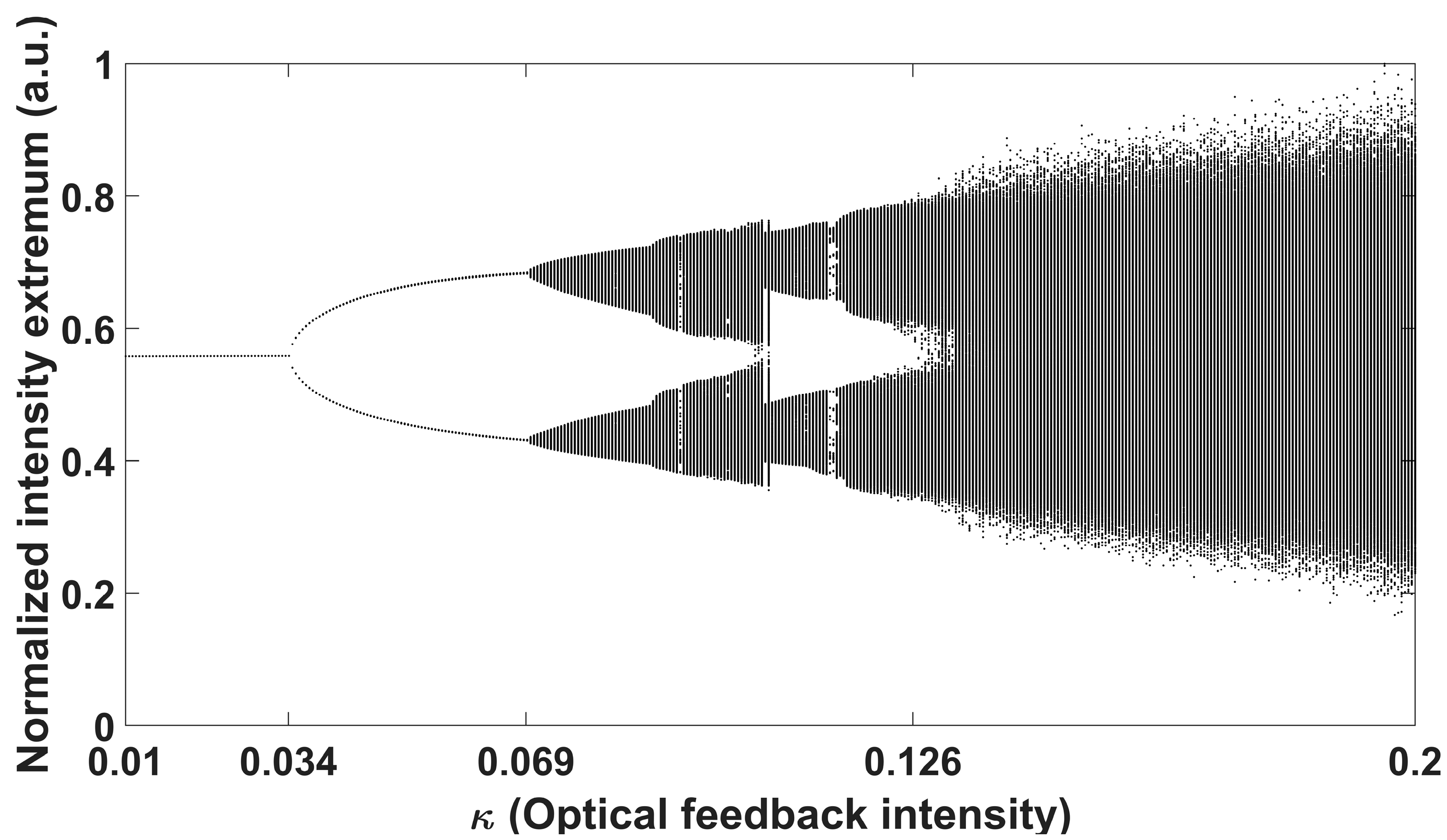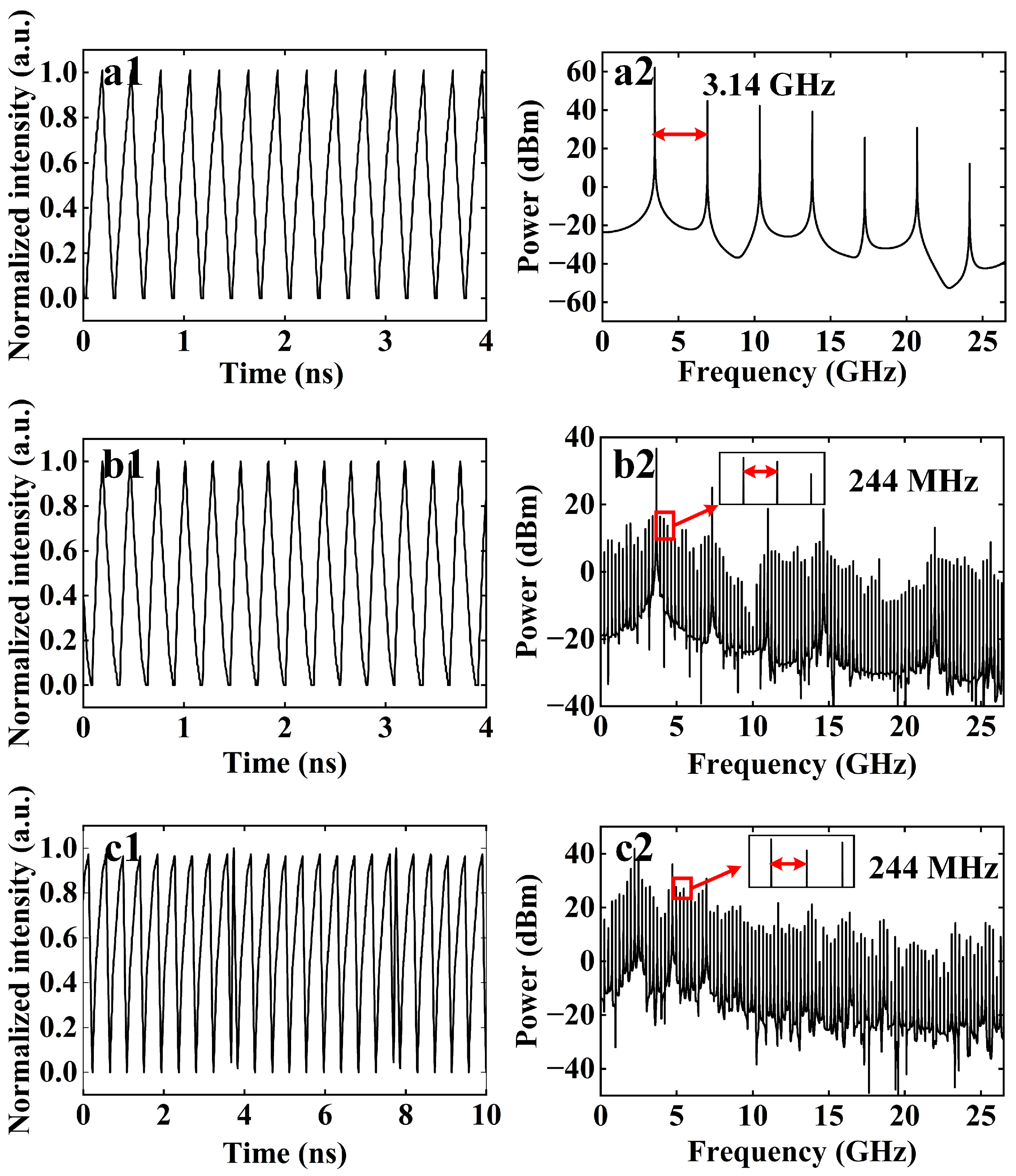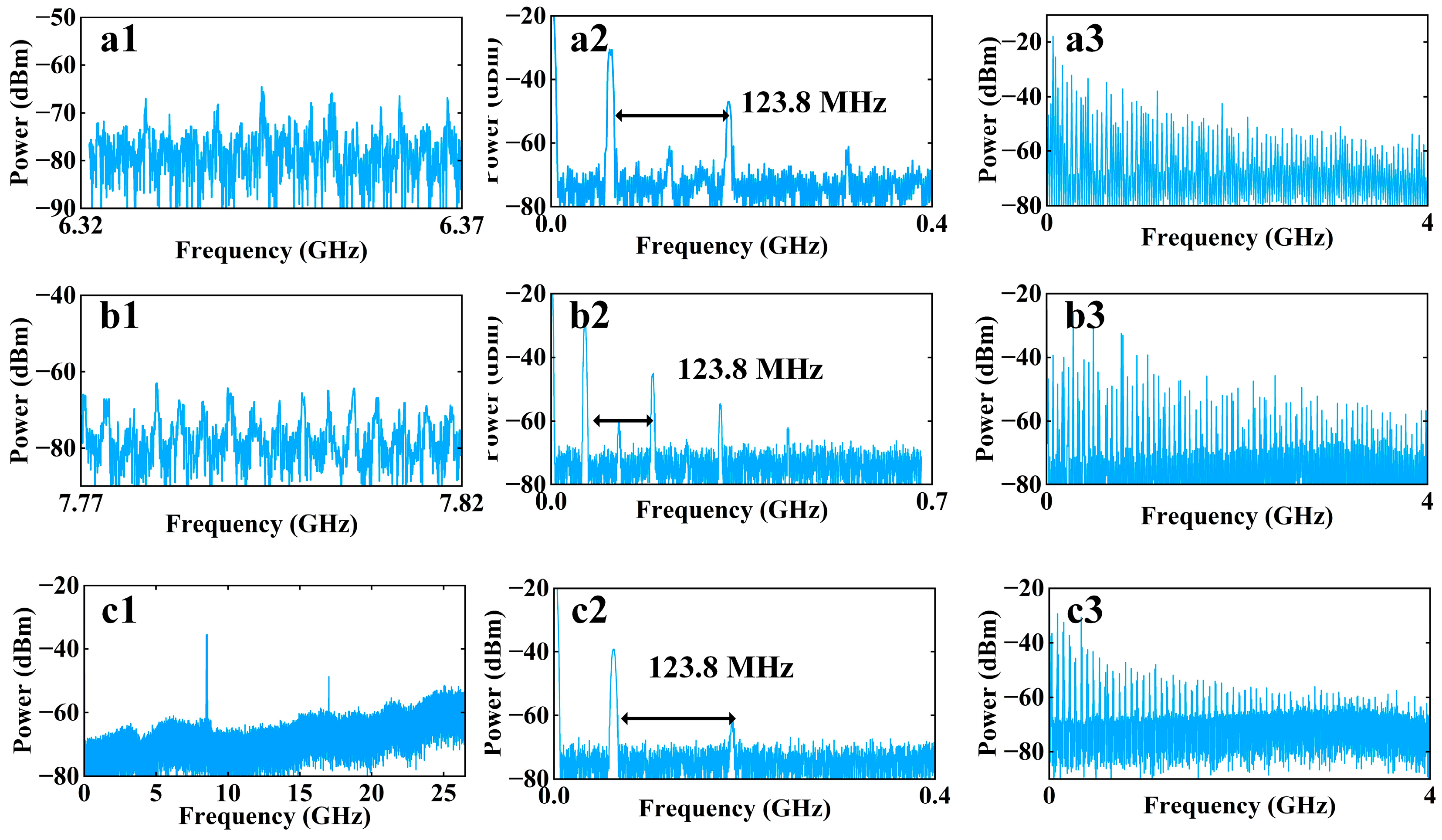1. Introduction
With the low nonlinear dynamic threshold, a semiconductor laser is easy to generate various dynamic states, such as period-one (P1), multi-period (MP), quasi-periodic (QP), injection-locked, four-wave mixing (FWM), chaos (CO) when it is subjected to external disturbances [
1,
2]. These dynamic states are of great value in photon microwave signals generation [
3,
4], photonic filters [
5], optical frequency combs generation [
6], and so on. The frequently used methods for generating nonlinear dynamics include master–slave optical injection [
7], mutual optical injection [
8], self-delayed feedback [
9], and optoelectronic feedback [
10]. Unfortunately, the master–slave optical injection generates microwave signals with large noise [
11]. The parameters of the mutual optical injection structure are not easy to control [
12]. In comparison, the structure of the self-delayed feedback is simple, and its parameters are easy to control. The dynamic state of a semiconductor laser based on the self-delayed feedback is sensitive to several parameters, including the bias current, operating temperature, polarization, injected power, and feedback delay. In general, the self-delay feedback structure can be achieved through a free space optical path [
13], integrated circuits [
14], and fiber links [
15]. The system based on a free space optical path is rarely studied due to its high loss and complexity. The integrated circuits of the self-delayed feedback are a short-delay system (the delay time is less than the relaxation oscillation time), then the dynamical state of the laser has a strong dependence on the phase delay. Nevertheless, the self-delay feedback based on fiber links is a long-delay system that is insensitive to the phase delay. Besides, the optoelectronic oscillation loop can be used as an optoelectronic oscillator (OEO), which is a typical optoelectronic feedback system with rich nonlinear dynamics. Some researchers utilize the DM-DFBL to replace the external modulators and lasers of the OEO loop. It saves costs and simplifies the structure. However, most of the studies have only focused on optical or electrical feedback structures individually, and often ignore the effect of the competition between the two on the lasers. It is important to study the dynamic state of the hybrid optical and optoelectronic structure. Although the hybrid structure has been investigated in prior studies, the scope of these investigations has been limited to the short-delay system [
16]. The theoretical study and experimental validation for the long-delay system are lacking. In addition, the hybrid optical and optoelectronic structure can also reduce the noise of the generated signal and improve the stability of the system [
17]. Therefore, the physical mechanisms of generating nonlinear dynamical states deserve an in-depth study when optical and optoelectronic hybrid systems function together.
This study presents a dual-loop configuration integrating a DM-DFBL self-delayed feedback with an optoelectronic oscillation loop to investigate nonlinear dynamic state generation. The proposed system establishes two distinct feedback pathways, which are an optical self-delayed feedback loop and an electrical feedback intensity modulation channel via the OEO circuit. Through systematic numerical simulations and experimental validation, we demonstrate the comprehensiveness of these coupled feedback mechanisms. Numerical investigations compare dynamical evolution under three configurations: pure optical feedback, standalone OEO operation, and their synergistic combination. Experimental verification tracks the transition pathways of dynamic states across these operational regimes and confirms numerical predictions with remarkable consistency. The established numerical model demonstrates strong predictive capability for laser dynamics, while experimental results validate the practical feasibility of this dual-loop architecture. This integrated approach not only deepens understanding of nonlinear generation mechanisms but also provides precise control over dynamic evolution. The demonstrated methodology offers theoretical foundations and technical solutions for advanced applications in optical communications, signal processing, and nonlinear photonic systems.
2. Principle
The schematic diagram of the DM-DFBL self-delayed feedback with an optoelectronic oscillation loop is shown in
Figure 1. The DM-DFBL self-delayed feedback structure is marked by a blue dashed frame, and the optoelectronic oscillation loop is marked by a red dashed frame. The DM-DFBL self-delayed feedback consists of a DM-DFBL, an optical circulator (Cir), an optical delay line (ODL), an optical coupler (OC1), an attenuator (ATT1), and a polarization controller (PC). The optoelectronic oscillation loop consists of a DM-DFBL, a Cir, an ODL, OC1, an erbium-doped fiber amplifier (EDFA), OC2, ATT2, a photodetector (PD), and an electric amplifier (EA). In this scheme, the nonlinear dynamical state of the DM-DFBL output is mainly controlled by the optical feedback intensity (
) and the electrical feedback intensity (
). In the DM-DFBL self-delayed feedback loop, the
is changed by adjusting ATT1. The polarization state of injected light and the internal optical field in DM-DFBL is controlled by the PC. When the polarization of the injected light and the cavity mode are matched, the nonlinear threshold of the DM-DFBL is minimized. In the optoelectronic oscillation loop, the optical signal is converted into an electrical signal through the PD and fed back to modulate the DM-DFBL.
Based on schematic diagrams and semiconductor rate equations [
9,
18], the rate equation for the optical and optoelectronic hybrid system can be expressed as follows:
where
,
, and
represent the carrier number, photon number, and phase, respectively. The set of equations describes the carrier number, photon number, and phase in the laser as a function of time.
is the optical feedback intensity, defined as the ratio of the injected power to the free-running power.
is electrical feedback intensity that is a dimensionless feedback parameter, denoting the effect of the optoelectronic oscillation loop on nonlinear dynamic states. In addition,
is the delay time of light in the optical feedback loop, and
is the delay time of light in an optoelectronic feedback loop. This ensures that the system is long-delayed (the delay time is more than the relaxation oscillation time: 0.112 ns) and saves computer facilities. Besides, the output power of DM-DFBL can be expressed as follows:
All the parameters and corresponding values are listed in
Table 1. The values are extracted from a typical semiconductor laser.
Equations (1)–(5) are solved numerically via the fourth-order Runge–Kutta algorithm. The time series and frequency spectrum of different dynamic states are obtained through numerical calculations. The bifurcation diagram of the dynamic states is obtained from successive extrema (maximum and minimum) of the amplitude in the time series when the optical feedback intensity takes different values. These results are used to analyze the dynamic behavior of the DM–DFBL.
Firstly, the dynamic states generated by the DM-DFBL self-delayed pure optical feedback are studied. The DM-DFBL exhibits the CO state, QP state, and P1 state with the decrease of optical feedback intensity, as shown in
Figure 2. When
, the time series are irregular waveforms with randomly varying peaks, and the frequency spectrum is continuous, as shown in
Figure 2(a1,a2). These results indicate that the laser is in the CO state.
Figure 2b demonstrates that, in the circumstance of
, the time series manifests a tendency towards periodicity, but each cycle exhibits distinct characteristics. Moreover, the frequency spectrum displays numerous oscillation modes, as shown in
Figure 2(b2). The intensity of these oscillation modes is found to be non-uniform, and the intervals between them are inconsistent. This indicates that the DM-DFBL is a QP state, which is an intermediate state between the chaotic and periodic states. When
, the time series are strictly sinusoidal signals, and the frequency spectrum exhibits a high-power oscillation mode with a frequency of about 8.513 GHz. In addition, the lower power oscillation modes at 17.026 GHz and 25.539 GHz are also identified in
Figure 2(c2), which are the higher-order modes of the P1 oscillation (a frequency-doubled signal and a frequency-triple signal). These results indicate that the laser is in the P1 state, which originates from the relaxation oscillations of the DM-DFBL. In order to more fully describe the distribution of the dynamical states of the DM-DFBL in parameter space, the bifurcation diagram is presented in
Figure 3.
Figure 3 shows the bifurcation diagram of the dynamics states that are generated based on DM-DFBL self-delayed pure optical feedback, with the variation of
. When
is smaller than 0.034, the feedback light is not enough to interfere with the output of the DM-DFBL; thus, the DM-DFBL is in a steady state. When
is more than 0.034, there is a maximum or a minimum at the same position, indicating that the DM-DFBL is in the P1 state. Meanwhile, the intensity of the P1 state is enhanced with the increase of
. When
is more than 0.069, the feedback light interacts with the cavity mode to induce multiplicative period bifurcations, resulting in multiple extreme points at the same position. It means that DM-DFBL is in the MP state or QP state. There is an increase in the number of extreme points with an increase in
. When
is more than 0.126, the intense competition between individual modes in the laser can occur, the bifurcations quickly increase, and the periodicity of the DM-DFBL is destroyed. Eventually, the DM-DFBL evolves to the CO state. This evolutionary process is called multiplicative period bifurcation, which is a typical dynamic state evolutionary process.
The dynamic behaviors of the optoelectronic oscillation loop are studied, as shown in
Figure 4. The optoelectronic oscillation loop can be considered as an OEO, which is a typical feedback system with rich nonlinear dynamic state characteristics. The rich dynamic behavior in the OEO benefits from the high-gain feedback.
Figure 4a shows the results for
. The time series presents a regular pulse signal, and there is a series of equally spaced frequency components with a frequency interval of 3.14 GHz in the frequency spectrum, i.e., the MFC. The MFC originates from the nonlinearity of the DM-DFBL because the injected electrical signal causes the laser to operate in the nonlinear region.
Figure 4b shows the results for
; it is evident that some frequency components with a frequency interval of 244 MHz and relatively low intensity appear between the MFC frequency components in the spectrum. The frequency interval of these components is called the free spectral range (FSR,
, where
is the velocity of optical,
is the effective refractive index of the transmission medium,
is the length of the OEO loop). These FSRs originate from the OEO oscillation eigenmodes, which are determined by the length of the OEO loop (corresponding time delay is 4 ns) and the relaxation oscillation time of the DM-DFBL. Nevertheless, the time series maintains regular pulse signals due to the MFC’s dominant influence.
Figure 4c shows the results for
. The MFC has essentially disappeared, and a set of FSRs with a frequency interval of 244 MHz is observed in the frequency spectrum. It is named the full-frequency oscillation from a self-locking state of the fundamental frequency [
19]. The regular pulse signal appears with burrs in the time series due to the spectrum components of the MFC still exists, as shown in
Figure 4(c1,c2). Moreover, due to the well-defined phase relationships among spectral components in pulse signals, the optoelectronic oscillation loop contributes to enhanced signal stability in experimental systems.
From the above results, it is seen that both the time series and frequency spectrum are capable of representing the same dynamic state. In order to reduce the length of the article without compromising its generalisability, the frequency spectrum is uniformly used without any particular cases in the subsequent discussion.
Based on the above results, the mutual effect of DM-DFBL self-delayed feedback and optoelectronic oscillation loops on the dynamic states is further explored. At first, the output of the DM-DFBL self-delayed feedback is set to the CO state and then introduced into the optoelectronic oscillation loop. When
and
, although the frequency spectra are still continuous, the oscillation modes around 8.5 GHz are all enhanced to different degrees, as shown in
Figure 5(a1,a2). When
, some oscillation envelopes appear near direct current (DC), with the corresponding frequency interval is about 244 MHz, as shown in
Figure 5(a3). This means that the optoelectronic oscillation loop is gradually dominating the output of the laser. But overall, the laser is still in the CO state, and the introduction of the optoelectronic oscillation loop enhances mode competition within the laser.
Next, the output of the DM-DFBL self-delayed feedback is set to the QP state and then introduced into the optoelectronic oscillation loop. In the case of
, the dynamic state of the DM-DFBL is transferred from the original QP (
Figure 2b) to the P1 state, as shown in
Figure 5(b1). The phenomenon is caused by the vernier caliper effect of the two oscillating modes of the self-delayed feedback loop and the optoelectronic oscillation loop. The optoelectronic oscillation loop can drive the QP state into a periodic state, owing to the inherent susceptibility of QP states to external disturbances. When
, a number of frequency components appear in the frequency spectrum, and the corresponding FSR is about 732 MHz (3 times the FSR of the OEO), which is also the MFC, as shown in
Figure 5(b2). When
, the periodic states in the frequency spectrum are destroyed, and the output of the laser develops towards the eigenoscillation of the OEO, as shown in
Figure 5(b3). This means that the optoelectronic oscillation loop is gradually dominating the output of the laser.
Finally, the output of the DM-DFBL self-delayed feedback is set to the P1 state and then introduced into the optoelectronic oscillation loop. When
and
, the output of the DM-DFBL is still in the P1 state, as shown in
Figure 5(c1,c2). There is no obvious change in the P1 state when compared to the case in the absence of the introduction of the optoelectronic oscillation loop (
Figure 2c). It is due to the limitation of the accuracy of the fourth-order Runge–Kutta algorithm in the numerical calculation process. In a subsequent experiment, the enhancement of the P1 state is found to have an obvious effect. When
, the oscillation mode with FSR = 244 MHz appears near DC, as shown in
Figure 5(c3). Consequently, this is further evidence that the optoelectronic oscillation loop is gradually dominating the output of the laser.
